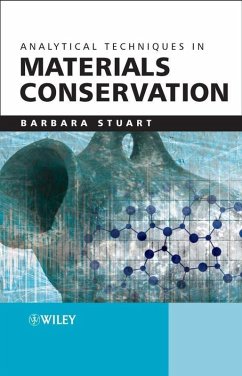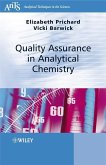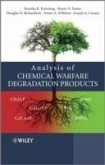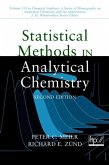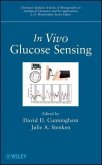Barbara H. Stuart
Analytical Techniques in Materials Conservation (eBook, PDF)
73,99 €
73,99 €
inkl. MwSt.
Sofort per Download lieferbar

0 °P sammeln
73,99 €
Als Download kaufen

73,99 €
inkl. MwSt.
Sofort per Download lieferbar

0 °P sammeln
Jetzt verschenken
Alle Infos zum eBook verschenken
73,99 €
inkl. MwSt.
Sofort per Download lieferbar
Alle Infos zum eBook verschenken

0 °P sammeln
Barbara H. Stuart
Analytical Techniques in Materials Conservation (eBook, PDF)
- Format: PDF
- Merkliste
- Auf die Merkliste
- Bewerten Bewerten
- Teilen
- Produkt teilen
- Produkterinnerung
- Produkterinnerung

Bitte loggen Sie sich zunächst in Ihr Kundenkonto ein oder registrieren Sie sich bei
bücher.de, um das eBook-Abo tolino select nutzen zu können.
Hier können Sie sich einloggen
Hier können Sie sich einloggen
Sie sind bereits eingeloggt. Klicken Sie auf 2. tolino select Abo, um fortzufahren.

Bitte loggen Sie sich zunächst in Ihr Kundenkonto ein oder registrieren Sie sich bei bücher.de, um das eBook-Abo tolino select nutzen zu können.
This book will introduce the reader to the wide variety of analytical techniques that are employed by those working on the conservation of materials. An introduction to each technique is provided with explanations of how data may be obtained and interpreted. Examples and case studies will be included to illustrate how each technique is used in practice. The fields studied include: inorganic materials, polymers, biomaterials and metals. Clear examples of data analysis feature, designed to assist the reader in their choice of analytical method.
- Geräte: PC
- mit Kopierschutz
- eBook Hilfe
- Größe: 2.98MB
Andere Kunden interessierten sich auch für
![Analytical Instrumentation (eBook, PDF) Analytical Instrumentation (eBook, PDF)]() Gillian McmahonAnalytical Instrumentation (eBook, PDF)93,99 €
Gillian McmahonAnalytical Instrumentation (eBook, PDF)93,99 €![A Practical Guide to Scientific Data Analysis (eBook, PDF) A Practical Guide to Scientific Data Analysis (eBook, PDF)]() David J. LivingstoneA Practical Guide to Scientific Data Analysis (eBook, PDF)69,99 €
David J. LivingstoneA Practical Guide to Scientific Data Analysis (eBook, PDF)69,99 €![Quality Assurance in Analytical Chemistry (eBook, PDF) Quality Assurance in Analytical Chemistry (eBook, PDF)]() Elizabeth PrichardQuality Assurance in Analytical Chemistry (eBook, PDF)63,99 €
Elizabeth PrichardQuality Assurance in Analytical Chemistry (eBook, PDF)63,99 €![Analytical Instrumentation (eBook, PDF) Analytical Instrumentation (eBook, PDF)]() Graham CurrellAnalytical Instrumentation (eBook, PDF)82,99 €
Graham CurrellAnalytical Instrumentation (eBook, PDF)82,99 €![Analysis of Chemical Warfare Degradation Products (eBook, PDF) Analysis of Chemical Warfare Degradation Products (eBook, PDF)]() Karolin K. KroeningAnalysis of Chemical Warfare Degradation Products (eBook, PDF)72,99 €
Karolin K. KroeningAnalysis of Chemical Warfare Degradation Products (eBook, PDF)72,99 €![Statistical Methods in Analytical Chemistry (eBook, PDF) Statistical Methods in Analytical Chemistry (eBook, PDF)]() Peter C. MeierStatistical Methods in Analytical Chemistry (eBook, PDF)197,99 €
Peter C. MeierStatistical Methods in Analytical Chemistry (eBook, PDF)197,99 €![In Vivo Glucose Sensing (eBook, PDF) In Vivo Glucose Sensing (eBook, PDF)]() In Vivo Glucose Sensing (eBook, PDF)123,99 €
In Vivo Glucose Sensing (eBook, PDF)123,99 €-
-
-
This book will introduce the reader to the wide variety of analytical techniques that are employed by those working on the conservation of materials. An introduction to each technique is provided with explanations of how data may be obtained and interpreted. Examples and case studies will be included to illustrate how each technique is used in practice. The fields studied include: inorganic materials, polymers, biomaterials and metals. Clear examples of data analysis feature, designed to assist the reader in their choice of analytical method.
Dieser Download kann aus rechtlichen Gründen nur mit Rechnungsadresse in D ausgeliefert werden.
Produktdetails
- Produktdetails
- Verlag: John Wiley & Sons
- Erscheinungstermin: 13. März 2007
- Englisch
- ISBN-13: 9780470060513
- Artikelnr.: 37290135
- Verlag: John Wiley & Sons
- Erscheinungstermin: 13. März 2007
- Englisch
- ISBN-13: 9780470060513
- Artikelnr.: 37290135
- Herstellerkennzeichnung Die Herstellerinformationen sind derzeit nicht verfügbar.
Barbara Stuart (BSc(Hons), MSc(Syd), PhD(Lond), DIC, MRSC, MRACI, Cchem) After graduating with a BSc degree from the University of Sydney in Australia, Barbara Stuart worked as a tutor at this university. She also carried out research in the field of biophysical chemistry in the Department of Physical Chemistry and graduated with a MSc in 1990. The author moved to the UK to carry out doctoral studies in polymer engineering within the Department of Chemical Engineering and Chemical Technology at Imperial College (University of London). After obtaining her PhD in 1993, she took up a position as Lecturer in Physical Chemistry at the University of Greenwich in London. Barbara joined the staff at the University of Technology, Sydney, Australia in 1995, where she is currently a Senior Lecturer in the Department of Chemistry, Materials and Forensic Science. She is presently conducting research in the fields of polymer spectroscopy, materials conservation and forensic science. Barbara is the author of three other books published by John Wiley and Sons, "Modern Infrared Spectroscopy" and "Biological Applications of Infrared Spectroscopy", both in the ACOL series of open learning texts, and "Polymer Analysis" and "Infrared Spectroscopy: Fundamentals and Applications" in the current ANTS series of texts.
1. Conservation materials.
1.1 Introduction.
1.2 Proteins.
1.3 Lipids.
1.4 Carbohydrates.
1.5 Natural resins.
1.6 Natural materials.
1.7 Synthetic polymers.
1.8 Dyes and pigments.
1.9 Textiles.
1.10 Paintings.
1.11 Written material.
1.12 Glass.
1.13 Ceramics.
1.14 Stone.
1.15 Metals.
2. Basic identification techniques.
2.1 Introduction.
2.2 Visual examination.
2.3 Chemical tests.
2.4 Density and specific gravity.
2.5 Solubility.
2.6 Heat tests.
3. Light examination and microscopy.
3.1 Introduction.
3.2 Infrared techniques.
3.3 Ultraviolet techniques.
3.4 Radiography.
3.5 Refractometry.
3.6 Optical microscopy.
3.7 Transmission electron microscopy.
3.8 Scanning electron microscopy.
3.9 Scanning probe microscopy.
4. Molecular spectroscopy.
4.1 Introduction.
4.2 Infrared spectroscopy.
4.3 Raman spectroscopy.
4.4 Ultraviolet-visible spectroscopy.
4.5 Photoluminescence spectroscopy.
4.6 Nuclear magnetic resonance spectroscopy.
4.7 Electron spin resonance spectroscopy.
4.8 Mössbauer spectroscopy.
5. Atomic spectroscopy.
5.1 Introduction.
5.2 Atomic absorption spectroscopy.
5.3 Atomic emission spectroscopy.
5.4 Laser induced breakdown spectroscopy.
6. X-ray techniques.
6.1 Introduction.
6.2 X-ray diffraction.
6.3 X-ray fluorescence spectroscopy.
6.4 Electron microprobe analysis.
6.5 Proton induced X-ray emission.
6.6 X-ray photoelectron spectroscopy and Auger spectroscopy.
7. Mass spectrometry.
7.1 Introduction.
7.2 Molecular mass spectrometry.
7.3 Secondary ion mass spectrometry.
7.4 Atomic mass spectrometry.
8. Chromatography and electrophoresis.
8.1 Introduction.
8.2 Paper chromatography.
8.3 Thin layer chromatography.
8.4 Gas chromatography.
8.5 High performance liquid chromatography.
8.6 Size exclusion chromatography.
8.7 Ion chromatography.
8.8 Capillary electrophoresis.
9. Thermal and mechanical analysis.
9.1 Introduction.
9.2 Thermogravimetric analysis.
9.3 Differential Scanning Calorimetry/Differential Thermal Analysis.
9.4 Tensile Testing.
9.5 Flexural Testing.
9.6 Thermal Mechanical Analysis.
9.7 Dynamic Mechanical Analysis.
9.8 Hardness.
10. Nuclear methods.
10.1 Introduction.
10.2 Radioisotopic dating.
10.3 Neutron activation analysis.
10.4 Luminescence.
10.5 Neutron diffraction.
Appendix Infrared spectra of polymers.
Index.
1.1 Introduction.
1.2 Proteins.
1.3 Lipids.
1.4 Carbohydrates.
1.5 Natural resins.
1.6 Natural materials.
1.7 Synthetic polymers.
1.8 Dyes and pigments.
1.9 Textiles.
1.10 Paintings.
1.11 Written material.
1.12 Glass.
1.13 Ceramics.
1.14 Stone.
1.15 Metals.
2. Basic identification techniques.
2.1 Introduction.
2.2 Visual examination.
2.3 Chemical tests.
2.4 Density and specific gravity.
2.5 Solubility.
2.6 Heat tests.
3. Light examination and microscopy.
3.1 Introduction.
3.2 Infrared techniques.
3.3 Ultraviolet techniques.
3.4 Radiography.
3.5 Refractometry.
3.6 Optical microscopy.
3.7 Transmission electron microscopy.
3.8 Scanning electron microscopy.
3.9 Scanning probe microscopy.
4. Molecular spectroscopy.
4.1 Introduction.
4.2 Infrared spectroscopy.
4.3 Raman spectroscopy.
4.4 Ultraviolet-visible spectroscopy.
4.5 Photoluminescence spectroscopy.
4.6 Nuclear magnetic resonance spectroscopy.
4.7 Electron spin resonance spectroscopy.
4.8 Mössbauer spectroscopy.
5. Atomic spectroscopy.
5.1 Introduction.
5.2 Atomic absorption spectroscopy.
5.3 Atomic emission spectroscopy.
5.4 Laser induced breakdown spectroscopy.
6. X-ray techniques.
6.1 Introduction.
6.2 X-ray diffraction.
6.3 X-ray fluorescence spectroscopy.
6.4 Electron microprobe analysis.
6.5 Proton induced X-ray emission.
6.6 X-ray photoelectron spectroscopy and Auger spectroscopy.
7. Mass spectrometry.
7.1 Introduction.
7.2 Molecular mass spectrometry.
7.3 Secondary ion mass spectrometry.
7.4 Atomic mass spectrometry.
8. Chromatography and electrophoresis.
8.1 Introduction.
8.2 Paper chromatography.
8.3 Thin layer chromatography.
8.4 Gas chromatography.
8.5 High performance liquid chromatography.
8.6 Size exclusion chromatography.
8.7 Ion chromatography.
8.8 Capillary electrophoresis.
9. Thermal and mechanical analysis.
9.1 Introduction.
9.2 Thermogravimetric analysis.
9.3 Differential Scanning Calorimetry/Differential Thermal Analysis.
9.4 Tensile Testing.
9.5 Flexural Testing.
9.6 Thermal Mechanical Analysis.
9.7 Dynamic Mechanical Analysis.
9.8 Hardness.
10. Nuclear methods.
10.1 Introduction.
10.2 Radioisotopic dating.
10.3 Neutron activation analysis.
10.4 Luminescence.
10.5 Neutron diffraction.
Appendix Infrared spectra of polymers.
Index.
1. Conservation materials.
1.1 Introduction.
1.2 Proteins.
1.3 Lipids.
1.4 Carbohydrates.
1.5 Natural resins.
1.6 Natural materials.
1.7 Synthetic polymers.
1.8 Dyes and pigments.
1.9 Textiles.
1.10 Paintings.
1.11 Written material.
1.12 Glass.
1.13 Ceramics.
1.14 Stone.
1.15 Metals.
2. Basic identification techniques.
2.1 Introduction.
2.2 Visual examination.
2.3 Chemical tests.
2.4 Density and specific gravity.
2.5 Solubility.
2.6 Heat tests.
3. Light examination and microscopy.
3.1 Introduction.
3.2 Infrared techniques.
3.3 Ultraviolet techniques.
3.4 Radiography.
3.5 Refractometry.
3.6 Optical microscopy.
3.7 Transmission electron microscopy.
3.8 Scanning electron microscopy.
3.9 Scanning probe microscopy.
4. Molecular spectroscopy.
4.1 Introduction.
4.2 Infrared spectroscopy.
4.3 Raman spectroscopy.
4.4 Ultraviolet-visible spectroscopy.
4.5 Photoluminescence spectroscopy.
4.6 Nuclear magnetic resonance spectroscopy.
4.7 Electron spin resonance spectroscopy.
4.8 Mössbauer spectroscopy.
5. Atomic spectroscopy.
5.1 Introduction.
5.2 Atomic absorption spectroscopy.
5.3 Atomic emission spectroscopy.
5.4 Laser induced breakdown spectroscopy.
6. X-ray techniques.
6.1 Introduction.
6.2 X-ray diffraction.
6.3 X-ray fluorescence spectroscopy.
6.4 Electron microprobe analysis.
6.5 Proton induced X-ray emission.
6.6 X-ray photoelectron spectroscopy and Auger spectroscopy.
7. Mass spectrometry.
7.1 Introduction.
7.2 Molecular mass spectrometry.
7.3 Secondary ion mass spectrometry.
7.4 Atomic mass spectrometry.
8. Chromatography and electrophoresis.
8.1 Introduction.
8.2 Paper chromatography.
8.3 Thin layer chromatography.
8.4 Gas chromatography.
8.5 High performance liquid chromatography.
8.6 Size exclusion chromatography.
8.7 Ion chromatography.
8.8 Capillary electrophoresis.
9. Thermal and mechanical analysis.
9.1 Introduction.
9.2 Thermogravimetric analysis.
9.3 Differential Scanning Calorimetry/Differential Thermal Analysis.
9.4 Tensile Testing.
9.5 Flexural Testing.
9.6 Thermal Mechanical Analysis.
9.7 Dynamic Mechanical Analysis.
9.8 Hardness.
10. Nuclear methods.
10.1 Introduction.
10.2 Radioisotopic dating.
10.3 Neutron activation analysis.
10.4 Luminescence.
10.5 Neutron diffraction.
Appendix Infrared spectra of polymers.
Index.
1.1 Introduction.
1.2 Proteins.
1.3 Lipids.
1.4 Carbohydrates.
1.5 Natural resins.
1.6 Natural materials.
1.7 Synthetic polymers.
1.8 Dyes and pigments.
1.9 Textiles.
1.10 Paintings.
1.11 Written material.
1.12 Glass.
1.13 Ceramics.
1.14 Stone.
1.15 Metals.
2. Basic identification techniques.
2.1 Introduction.
2.2 Visual examination.
2.3 Chemical tests.
2.4 Density and specific gravity.
2.5 Solubility.
2.6 Heat tests.
3. Light examination and microscopy.
3.1 Introduction.
3.2 Infrared techniques.
3.3 Ultraviolet techniques.
3.4 Radiography.
3.5 Refractometry.
3.6 Optical microscopy.
3.7 Transmission electron microscopy.
3.8 Scanning electron microscopy.
3.9 Scanning probe microscopy.
4. Molecular spectroscopy.
4.1 Introduction.
4.2 Infrared spectroscopy.
4.3 Raman spectroscopy.
4.4 Ultraviolet-visible spectroscopy.
4.5 Photoluminescence spectroscopy.
4.6 Nuclear magnetic resonance spectroscopy.
4.7 Electron spin resonance spectroscopy.
4.8 Mössbauer spectroscopy.
5. Atomic spectroscopy.
5.1 Introduction.
5.2 Atomic absorption spectroscopy.
5.3 Atomic emission spectroscopy.
5.4 Laser induced breakdown spectroscopy.
6. X-ray techniques.
6.1 Introduction.
6.2 X-ray diffraction.
6.3 X-ray fluorescence spectroscopy.
6.4 Electron microprobe analysis.
6.5 Proton induced X-ray emission.
6.6 X-ray photoelectron spectroscopy and Auger spectroscopy.
7. Mass spectrometry.
7.1 Introduction.
7.2 Molecular mass spectrometry.
7.3 Secondary ion mass spectrometry.
7.4 Atomic mass spectrometry.
8. Chromatography and electrophoresis.
8.1 Introduction.
8.2 Paper chromatography.
8.3 Thin layer chromatography.
8.4 Gas chromatography.
8.5 High performance liquid chromatography.
8.6 Size exclusion chromatography.
8.7 Ion chromatography.
8.8 Capillary electrophoresis.
9. Thermal and mechanical analysis.
9.1 Introduction.
9.2 Thermogravimetric analysis.
9.3 Differential Scanning Calorimetry/Differential Thermal Analysis.
9.4 Tensile Testing.
9.5 Flexural Testing.
9.6 Thermal Mechanical Analysis.
9.7 Dynamic Mechanical Analysis.
9.8 Hardness.
10. Nuclear methods.
10.1 Introduction.
10.2 Radioisotopic dating.
10.3 Neutron activation analysis.
10.4 Luminescence.
10.5 Neutron diffraction.
Appendix Infrared spectra of polymers.
Index.
